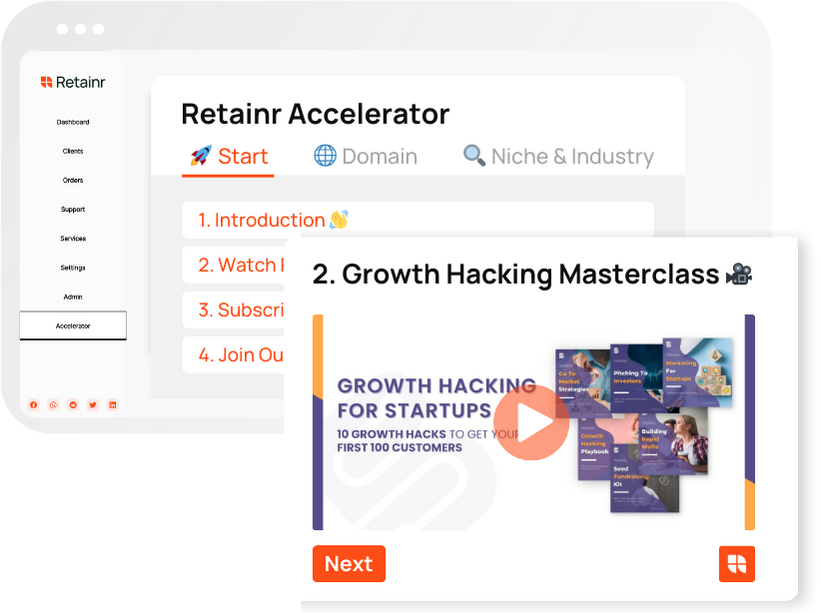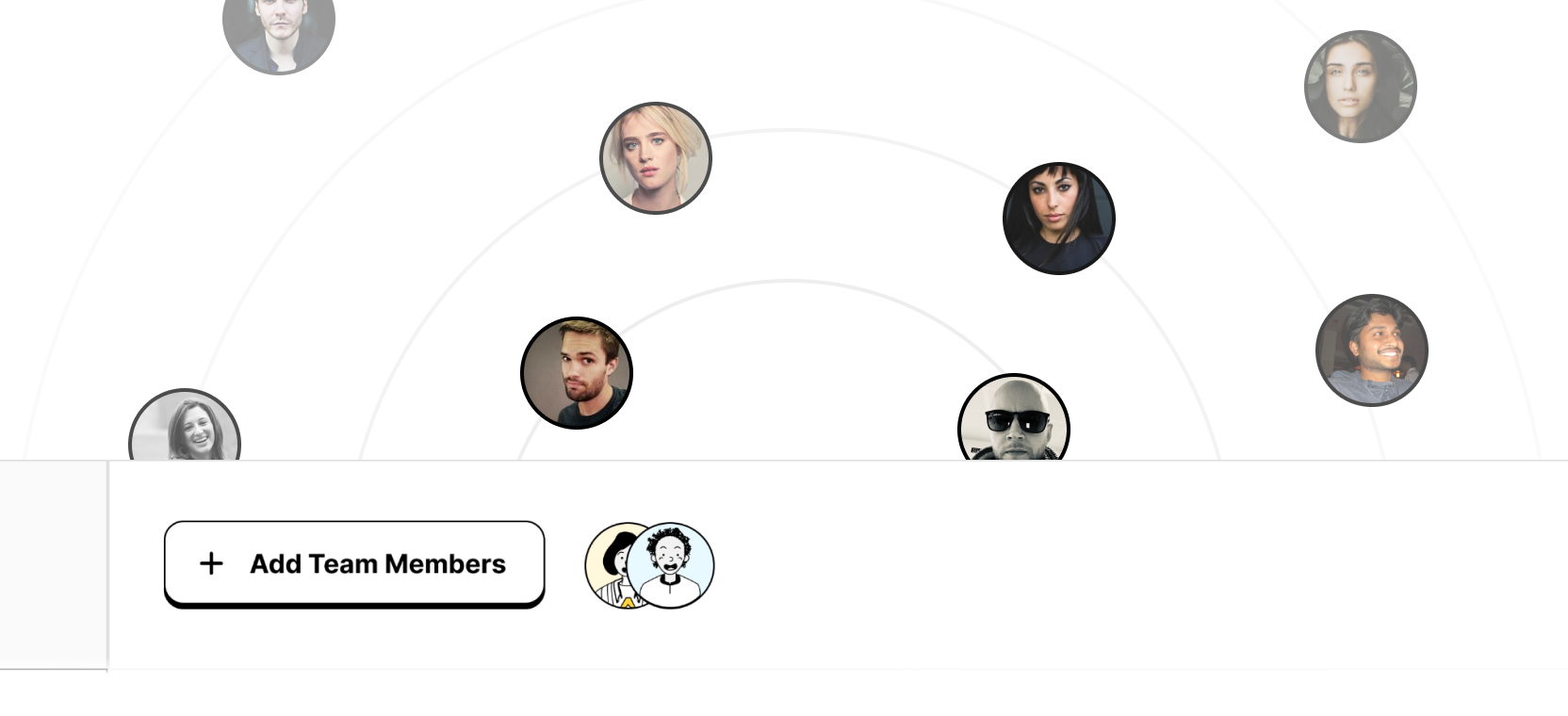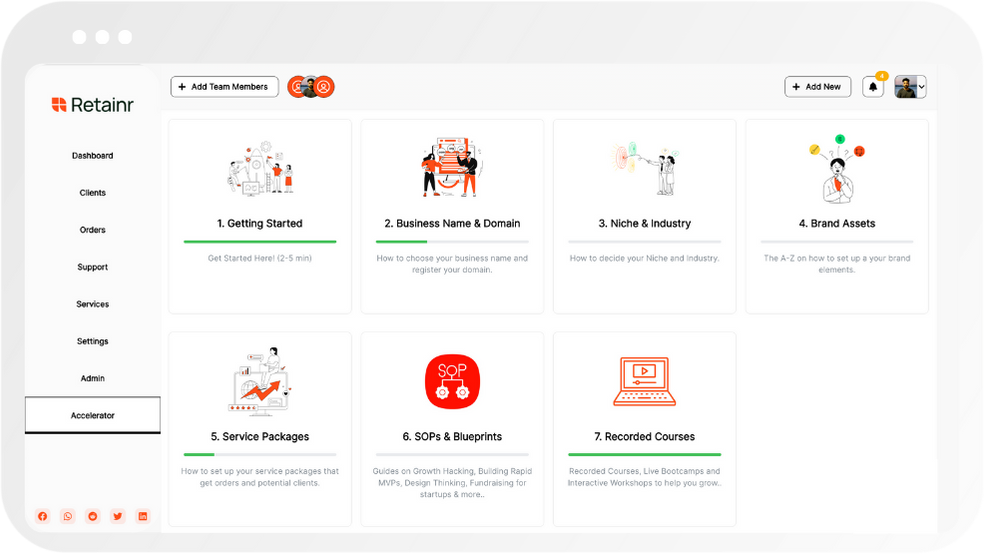
How to Build Your AI Chatbot with NLP in Python?
Build with Retainr
Sell your products and services, manage clients, orders, payments, automate your client onboarding and management with your own branded web application.
Get Started1. What is an AI Chatbot and what is its use?
What is an AI Chatbot?
An AI Chatbot, or Artificial Intelligence Chatbot, is a highly sophisticated piece of software designed to simulate human-like conversations with users. It works in a straightforward yet complex way; you send it an input, such as a question or a statement, and it will generate a response to match. The chatbot achieves this using Machine Learning and Natural Language Processing (NLP) technologies, allowing it to learn from past interactions and provide more accurate responses over time.
What is its Use?
The use of AI Chatbots has seen rapid growth in numerous industries due to their ability to improve customer service, sales, and support. Following are some of the primary uses of AI Chatbots:
- Customer Service: AI chatbots can handle common customer inquiries 24/7, resulting in increased satisfaction and significant cost savings.
- E-Commerce: Chatbots can assist customers in finding products, answering product-specific questions, and even processing transactions.
- Internal Operations: Companies use Chatbots internally to automate functions such as IT support or HR questions, saving employee time and resources.
AI Chatbots in Various Industries
AI chatbots have found applications in various industries. Here are few examples:
| Industry | Use Case |
|---|---|
| Healthcare | Patient engagement, scheduling appointments, medication reminders |
| Finance | Conducting transactions, providing stock market updates, financial advice |
| Education | Student engagement, assignment reminders, learning support |
2. What is NLP and how is it used in building an AI Chatbot?
Understanding Natural Language Processing (NLP)
Natural Language Processing (NLP), an integral area of artificial intelligence (AI), works by enabling computers to interpret, understand and respond to human languages in a valuable way. This technology is primarily used in various domains like chatbots, translation services, sentiment analysis and content summary. In terms of AI chatbots, NLP is used to understand and process human language, helping bots to interpret user inputs and provide accurate and relevant responses.
Key components of NLP include:
- Syntax: This deals with the arrangement of words to create grammatically correct sentences. AI chatbots use this information to break down and analyse user input.
- Semantics: This involves understanding the meaning of words and how they're connected to form a sentence. NLP bots use semantic analysis to understand the context behind user input.
- Sentiment Analysis: This refers to the process of determining whether a chunk of text has a negative, positive or neutral tone. AI chatbots use sentiment analysis to gauge user emotion and sentiment to provide better responses.
The Role of NLP in AI Chatbots
Creating an intelligent and effective chatbot greatly relies on NLP. Here's a simple breakdown of how NLP functions in chatbot creation:
- User Input Processing: Firstly, the AI chatbot, using NLP, interprets and analyses user inputs. NLP model breaks down the input into sentences, phrases and words, determining their root forms.
- Understanding User Intent: Post-processing, the bot needs to understand the context and user intent. Using semantic analysis, the bot determines what the user actually wants to convey.
- Generating Appropriate Response: After understanding the user's intent, the bot, using pre-determined templates or generating a new set of sentences, responds to the user.
However, it is also important to remember that NLP is a rapidly advancing field, and as improvements are made, the way we use it to build AI chatbots will also evolve.
3. What are the prerequisites for building an AI Chatbot using NLP in Python?
Knowledge Base Requirements
There are a number of prerequisites that you should consider when planning to build an AI chatbot using NLP in Python. Firstly, you should have a basic understanding of the Python programming language. Familiarity with its syntax, data types, control structures, and simple I/O handling forms the foundation for more complex tasks.
| Area | Knowledge Required |
|---|---|
| Programming Language | Python |
| Python Libraries | NLTK, TensorFlow, Keras |
| Coursework | Machine Learning, AI |
You should also be knowledgeable in essential Python libraries for this task. Libraries such as Natural Language Toolkit (NLTK), TensorFlow, and Keras are crucial for the processing of natural language and the training of AI models. Moreover, a background in topics such as machine learning and artificial intelligence is an added advantage.
Prior Skills and Training
For successful chatbot development, certain skills and previous training play a fundamental role.
- Structuring Conversational Flows: A chatbot should be able to guide a conversation logically to meet a certain goal. Understanding how to structure this is pivotal.
- Designing Human-Like Conversations: The aim of a chatbot is to interact with users as naturally as possible. Designing user-friendly and human-like conversation is crucial.
- Data Analysis: Understanding the data you are working with and knowing how to analyze it plays an important role in the chatbot's effectiveness.
Technical Infrastructure
Lastly, having the proper technical infrastructure is a must. Having a powerful computer system with robust processing power and ample memory is beneficial as machine learning models tend to be resource-intensive.
| Hardware Requirements | Description |
|---|---|
| Processor | Robust CPU preferably multi-core for efficient computations. |
| Memory | High RAM capacity for handling large data sets. |
| Storage | Adequate storage space for storing model and data files. |
4. Can you provide a step-by-step guide on how to build an AI Chatbot with NLP in Python?
Step 1: Installing Required Libraries and Setting Up Environment
The first step in building an AI chatbot with NLP in Python is setting up the required environment. Here, we have various libraries such as Natural Language Toolkit (NLTK), TensorFlow, TFlearn, etc. To install these, you can use the Python's pip package installer by typing the following commands in your terminal:
pip install nltkpip install tensorflowpip install tflearnpip install numpy
Step 2: Importing libraries and Load Data
After installing these libraries, you need to import them into your Python script. import nltkfrom nltk.stem import WordNetLemmatizerlemmatizer = WordNetLemmatizer()import jsonimport pickle
Next, load your dataset. The data can be structured in a JSON file. JSON file will have two main parts: 'tag' and 'patterns'. 'Tag' contains the category of the user's input, 'Patterns' contains a list of user inputs that your chatbot will compare with the user's input and the 'Responses' will be your chatbot's reply.
Step 3: Data Preprocessing and Training Model
Preprocessing involves tokenizing, lemmatizing and padding your data. Tokenizing is the process of splitting the whole text into small parts like words. Here is an example:words = nltk.word_tokenize(patterns)
Lemmatizing is the process of converting a word into its base form.
Training model is the next step after data preprocessing. You can use various models such as Sequential, dense, etc. The model can be trained as shown below:model.fit(training, output_empty, epochs=200, batch_size=5, verbose=1)
5. Which Python libraries are essential for developing an AI Chatbot with NLP?
Essential Python Libraries for Developing an AI Chatbot with NLP
Several Python libraries are essential for building an AI Chatbot using Natural Language Processing (NLP). These libraries possess pre-built functionalities that simplify the development process, speeding up the creation of efficient and reliable AI chatbots. Let's delve into some of these essential libraries.
- NLTK (Natural Language Toolkit): This library is a powerful tool, particularly for academic projects. It comprises robust modules for handling and processing human language data.
- spaCy: spaCy is a high-speed Python library designed for NLP. The reason for its popularity is its efficiency and the fact that it comes with pre-trained models.
- ChatterBot: ChatterBot makes building AI chatbots easy. It learns from previous user inputs to generate responses.
Besides these, Tensorflow and scikit-learn are Python libraries that play a vital role in building chatbots. Here is a quick comparison table of these libraries:
| Python Library | Functionality |
|---|---|
| NLTK | Text Manipulation, Tokenization, Speech Tagging, and Parsing |
| spaCy | Part-of-Speech (POS) Tagging, Dependency Parsing, Named Entity Recognition (NER), and Text Classification |
| ChatterBot | Learning from input data, generating responses |
| TensorFlow | High Performing Numeric Computations, Deep Learning Models |
| Scikit-learn | Machine learning algorithms, data mining, and data analysis |
The choice of Python libraries depends largely on the required features and level of complexity of the chatbot. Selecting the right tools will ensure the chatbot's capability of simulating intelligent conversation.
6. How can I train the AI Chatbot using NLP in Python?
Setting Up Training Data
To train your AI chatbot using NLP in Python, you need to first set up your training data. This data needs to be classified into 'intents', which is basically what the user intends to ask the chatbot. Each intent is a combination of 'patterns' (possible questions the user could ask) and their 'responses' (appropriate responses the chatbot should provide in each case). These intents can be stored in a JSON file. Check the example below:
```html{ "intents": [ { "tag": "greeting", "patterns": ["Hi", "Hey", "Is anyone there?", "Hello"], "responses": ["Hello", "Hey there"] }, { "tag": "goodbye", "patterns": ["Bye", "See you later", "Goodbye"], "responses": ["See you later", "Have a nice day"] }, ]}```Creating a Machine Learning Model for Training
To create a chatbot able to learn and improve its responses, you deploy machine learning models. Import libraries such as numpy, tensorflow, and tflearn to build and train your model. Firstly, process your data into Bag of Words technique and one-hot encode the tags. Then, use TFLearn to build a two-layer neural network. To train this network, fit it with your training data, set a batch size, and determine the number of epochs as shown:
```htmlimport numpy as npimport tensorflow as tfimport tflearnfrom sklearn.preprocessing import LabelEncoder# preprocessing datale = LabelEncoder()tags = le.fit_transform(tags)# building neural networknet = tflearn.input_data(shape=[None, len(train_x[0])])net = tflearn.fully_connected(net, 8)net = tflearn.fully_connected(net, 8)net = tflearn.fully_connected(net, len(train_y[0]), activation='softmax')net = tflearn.regression(net)# define and train the modelmodel = tflearn.DNN(net)model.fit(train_x, train_y, n_epoch=1000, batch_size=8, show_metric=True)```
Saving the Model After Training
After training your model, it's important to save it for future use. This will save all the weights and biases in your network that have been learned during training, allowing you to use this knowledge in future dialogues without needing to retrain the network every time. To save your model, use the .save() function from TFLearn as shown:
```htmlmodel.save('model.tflearn')```7. What kind of data is needed to train an AI Chatbot with NLP?
Understanding the Essentials of Training Data for AI Chatbot
In the realm of training your AI chatbot, data plays a highly significant role. The better the quality and quantity of your data, the more intelligently and accurately your chatbot will function. There are three main types of data you need for training an AI chatbot with NLP: Corpus data, Intents data, and Entities data.
- Corpus data: It consists of large amounts of text data. This data is used to train the chatbot about the language and its nuances. It helps the chatbot to understand different phrases, sentences, and their meanings.
- Intents data: These are predefined responses the chatbot can give to specific inputs from the user. They are associated with common user enquiries, requests or commands. The more intents data the chatbot has, the more user inputs it can handle accurately.
- Entities data: These are the variables that modify the intent. They provide specific data that the chatbot can apply to a user's intent. For example, in the sentence "Schedule a meeting for tomorrow", "tomorrow" is the entity as it gives specific context to the intent.
A Look into Example Data Types
Below is a table that shows a few examples of intents and entities in training an AI chatbot.
| Intents | Entities |
|---|---|
| Schedule Meeting | Tomorrow, 10 AM |
| Weather Inquiry | New York, Today |
| Book Flight | London, 20th Dec |
Importance of Quality Data
The quality and diversity of your training data can greatly affect the performance of your chatbot. You need to ensure that your corpus data accurately represents the kind of language and phrases your chatbot is likely to encounter. The intents and entities need to cover a wide range of user queries and variables to ensure the chatbot can understand and respond to most user inputs. Regular updates and iterations of the data set would continually improve the performance of the chatbot.
8. How can I improve the accuracy of the responses of my AI Chatbot using NLP in Python?
Improving the Accuracy of AI Chatbot Responses with NLP
The accuracy of an AI chatbot is crucial for its effectiveness, and you can improve it by implementing key strategies in your Python code. Firstly, you should ensure that your model is well trained. A machine learning model learns from past experiences or data, hence, you should provide a rich, diverse, and well-cleaned dataset during the training phase. Also, consider using deep learning methods, like recurrent neural networks (RNN), for better modeling of sequential data and improved prediction.
Another significant way to enhance the accuracy of the AI chatbot responses is by optimizing its NLP feature extraction techniques, such as:
- Tokenization: Dividing text into words or sentences. The tools must be chosen carefully to deal with contractions, symbols, and different languages.
- Stopwords Removal: Stop words are the most common words in a language like 'the', 'is', 'in' etc. Removing them can help reduce the processing time and improve efficiency.
- Stemming: This is a method used to reduce a word to its root form. It assists in achieving model consistency across different tenses and forms of the words.
Additionally, handling errors and exceptions correctly in your bot scripting can prevent unforeseen inaccuracies. The ongoing evaluation is also a crucial part of making your chatbot more intelligent. Here is a simple table that illustrates factors that could influence chatbot accuracy:
| Factors | Description |
|---|---|
| Training Data | The quality and diversity of the training dataset greatly influence your bot's ability to understand and respond accurately. |
| NLP Techniques | Proper implementation of NLP techniques such as Tokenization, Stopwords, and Stemming can significantly improve accuracy. |
| Error Handling | Proper scripting that predicts and addresses possible errors helps in maintaining consistency. |
| Ongoing Evaluation | Constantly monitoring and adjusting the chatbot can help make it more intelligent over time. |
9. Are there any potential challenges I might face in building an AI Chatbot with NLP in Python?
Potential Challenges in Building an AI Chatbot with NLP in Python
Building an AI chatbot with Natural Language Processing (NLP) in Python can be a compelling and sophisticated journey. Despite python's extensive libraries and tools that ease the process, you may encounter several obstacles. These challenges can range from a lack of expertise in specific areas, the complexity of the technology, to the difficulties in building a truly conversational bot.
- Lack of Domain-Specific Knowledge: It might be a challenge stemming from the need for extensive knowledge in the various fields involved such as Artificial Intelligence (AI), Machine Learning (ML), Natural Language Processing (NLP), and Python.
- Processing Natural Language: Teaching a machine to understand, process, and generate human language can be complicated. The complexities of semantics, sarcasm, idioms, and expressions may pose a significant challenge.
- Data Collection and Data Privacy: Training a bot requires a massive amount of conversational data. However, amassing, storing and managing these datasets, while ensuring data privacy, can be a significant hurdle.
- Building a "Conversational" Chatbot: While it's easier to build a bot that can handle simple queries, building one that can comprehend and respond to open-ended conversations is complex.
Lets dive deeper into these problems:
| Challenge | Detail | Proposed Solution |
|---|---|---|
| Lack of Domain-Specific Knowledge | AI, ML, NLP and python programming might be overwhelming to beginners. | Start with basic Python programming and gradually upgrade your knowledge in AI, ML and NLP. |
| Processing Natural Language | Building a bot that understands the complexity of human language is hard. | Use libraries like SpaCy, NLTK that come with tools for dealing with these complexities. |
| Data Collection and Data Privacy | Amassing quality conversational data without violating privacy regulations is challenging. | Use public conversational datasets or synthetic data that simulates real-world scenarios. |
| Building a "Conversational" Chatbot | Designing a bot that can handle open-ended conversations is complex. | Implementing techniques like Contextual AI can help solve this problem. |
10. What are the best practices or tips for building an AI Chatbot with NLP in Python effectively?
Choose the Right Tools and Libraries
Ensure you choose the right tools and libraries for building your AI chatbot. Python has a number of libraries that are powerful and easy to use for developing chatbots, such as NLTK, Spacy, ChatterBot and TensorFlow. These libraries can help you in parsing the human language, understanding semantics, recognizing speech and implementing machine learning algorithms. Here's a table of these popular libraries:
| Library | Description |
|---|---|
| NLTK | Popular library for text processing and symbolic and statistical natural language processing |
| Spacy | Advanced library for advanced natural language understanding |
| ChatterBot | Python library for building conversational engines and creating intelligent chatbots |
| TensorFlow | Open-source library for machine learning and artificial intelligence tasks |
Focus on Training your AI Chatbot
Training your chatbot is one of the most crucial steps in building an AI chatbot. A well-trained chatbot can understand user inputs better, deliver more accurate responses and provide a superior user experience. Here are some best practices:
- Prepare comprehensive and diverse training data that covers a wide range of possible user inputs.
- Consider using supervised learning, where the chatbot is trained using human annotated data.
- Test the chatbot with different data sets to avoid overfitting and underfitting.
- Regularly update and retrain your chatbot to deal with changing user inquiries and to improve performance.
Ensure Scalability and Compatibility
In the final stages of building your chatbot, ensuring its scalability and compatibility with various platforms is important. As your user base grows, your chatbot should be capable of handling multiple requests per second. It should be compatible and can be easily integrated with various messenger platforms like Facebook Messenger, Slack, WhatsApp, etc. Remember:
- Make your chatbot platform-agnostic so it could operate on any platform with minimal changes.
- Perform stress and performance tests to ensure your chatbot can manage a surge in user requests.
- Consider deploying your chatbot on cloud services for seamless scalability and usability.
Conclusion
Building your AI Chatbot with NLP in Python
In today's digital era, Artificial Intelligence based chatbots have taken center stage. They have become more powerful, flexible, and user-friendly than ever before. To leverage this technology, one would need to delve into Natural Language Processing (NLP), and Python is an excellent platform for this.Here's how to build your AI chatbot with NLP in Python:1. Plan your Chatbot
The first key to building a successful chatbot is planning. Define what tasks your chatbot will perform, its functionality, and the problems it will solve.2. Understanding NLP
NLP is a branch of AI that teaches machines to understand and interpret human language. Key aspects of NLP include Natural Language Understanding (NLU), Natural Language Generation (NLG) and Sentiment Analysis.3. Utilizing Python's NLP Libraries
Python's NLP libraries are comprehensive and flexible. Libraries such as NLTK, Spacy and TextBlob provide powerful tools to handle most NLP tasks.4. Constructing your Chatbot
Python has various libraries specifically for chatbot development, such as Chatterbot and PaddlePaddle. These libraries come with pre-built conversational models that can be trained on your customized data.5. Training and Testing
Finally, the chatbot needs to be trained with multiple conversation iterations and tested for accuracy and efficiency.While creating a chatbot can be a complex task, it is definitely rewarding and could revolutionize the way you do business.Retainr.io, a white-label software, could be your partner in this endeavor. Retainr.io provides a platform to sell, manage clients, orders & payments with your own branded app. Embrace the digital transformation with your own AI chatbot and let Retainr.io manage all your software needs. Explore our offerings today and step into the future of business.Boost Your Agency Growth
with Retainr Accelerator
Uncover secrets, strategies, and exclusive blueprints to take your agency's growth to the next level — from marketing insights to effective presentations and leveraging technology.

SOPs, Cheatsheets & Blueprints
Leverage 50+ SOPs (valued over $10K) offering practical guides, scripts, tools, hacks, templates, and cheat sheets to fast-track your startup's growth.
Connect with fellow entrepreneurs, share experiences, and get expert insights within our exclusive Facebook community.
.jpg)

Join a thriving community of growth hackers. Network, collaborate, and learn from like-minded entrepreneurs on a lifelong journey to success.

Gain expertise with recorded Courses, Live Bootcamps and interactive Workshops on topics like growth hacking, copywriting, no-code funnel building, performance marketing and more, taught by seasoned coaches & industry experts.

.jpg)

.jpeg)


